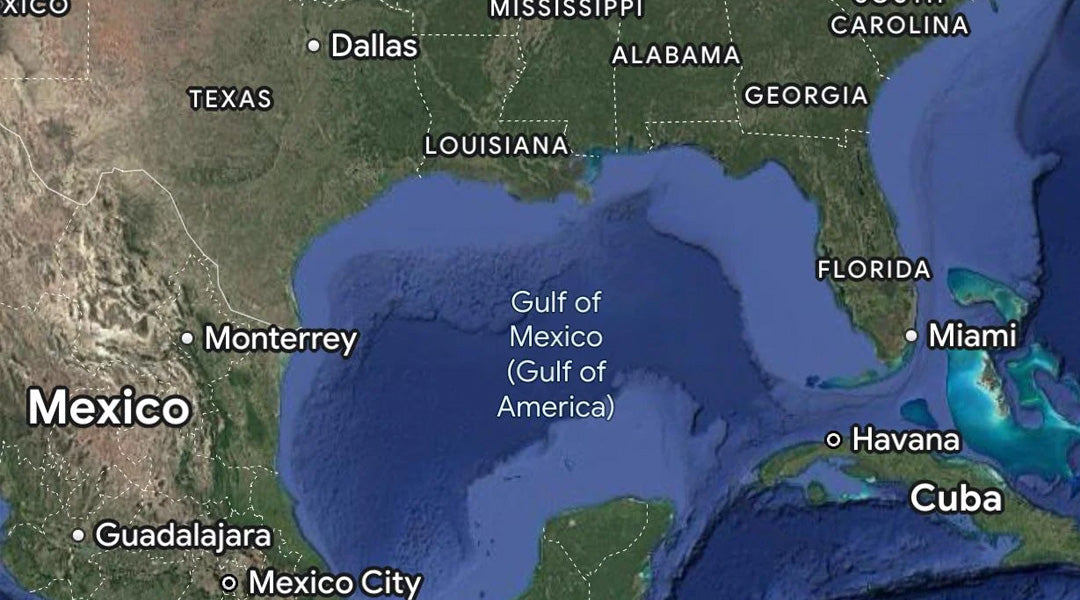
Google Maps Officially Renames Gulf of Mexico as U.S. Gulf
CLinaShare
On Monday, February 10, 2025, Google announced in a statement that it has officially renamed the "Gulf of Mexico" to the "Gulf of America," implementing the change first within its maps application in the United States. This unprecedented move stems mainly from an executive order signed earlier by President Trump, mandating that official maps used by government agencies update the name from "Gulf of Mexico" to "Gulf of America."

For many Google Maps users in the United States and Canada, the app now displays "Gulf of America." Users in Mexico will continue to see "Gulf of Mexico," while users in other parts of the world will see both names, with "Gulf of Mexico" appearing first followed by "Gulf of America" in parentheses. However, the news has prompted widespread surprise and skepticism: Why change the name? What impact might this have on geographical concepts and international relations?
Is the Gulf of Mexico now history?
Meanwhile, Apple Maps has not followed this change and continues to use the traditional name "Gulf of Mexico." Many users applaud Apple's steadfastness, arguing that it should not act merely on a government decree and that historical names deserve respect. Some also note that this position may endear Apple Maps to those who oppose administrative interference, though it could miss an opportunity to collaborate with government entities.
Interestingly, users from different countries searching for "Gulf of Mexico" or "Gulf of America" obtain varying results. An Australian user discovered that their phone still shows "Gulf of Mexico," and typing "Gulf of America" even triggers an auto-correction back to "Gulf of Mexico," as if the term "Gulf of America" doesn't exist.

Mixed reviews from multiple perspectives
Opinions on this phenomenon are mixed. Some believe that worldwide map naming conventions generally adhere to the names recognized by official or international organizations, so Google's decision to comply with the new U.S. government regulation is merely succumbing to circumstances, without regard to historical nomenclature. Others, however, express confusion and opposition to this practice, arguing that government intervention in place names contravenes public understanding of geography and culture, potentially causing confusion in geographical learning and international interactions.
- Proponents argue that within the scope of national sovereignty, map labeling should be autonomous and controlled, and technology companies must follow legal mandates.
- Opponents believe that geographical names should maintain historical and cultural continuity, and excessive administrative intervention only incites public resistance.
Behind the Name Change: Politics, Economics, or Culture?
If it were merely a change in map names, it might not have caused such a global uproar, but the political maneuvering, cultural identity, and commercial considerations it reflects are worthy of contemplation. Especially under the current international circumstances, "renaming" is far from being as trivial as a simple administrative document.
- Political aspect: The executive order demonstrates the U.S. government's desire to reshape boundary awareness in its official discourse, promoting the term "Gulf of America" widely within the country.
- Economic aspect: Large tech companies operating in the vast U.S. market cannot afford to ignore government directives. Non-compliance could result in stringent reviews or other forms of covert pressure.
- Cultural aspect: For most people, once a name is established, "memory" will follow and be passed down through generations. This move may, to some extent, impact the public's "cultural map" perception.
Future Impact and Possible Directions
Many are curious whether this name change is merely a fleeting occurrence or if it will have a lasting effect on people's perception of the Gulf of Mexico. Here are a few trends to watch:
1、Whether other international map services will follow suit
If more map service platforms, such as Bing Maps or OpenStreetMap, follow suit, the impact of the renaming could broaden further, compelling the international community to reassess the name of this body of water.
2、Challenges in geographic and cultural education
What will the children of the future learn in their geography textbooks at school—“Gulf of Mexico” or “Gulf of America”? Will educational publishers and academic institutions be forced to revise their materials? These are subsequent issues worth noting.
3、Public opinion fermenting
In the internet age, public sentiment and policy changes are tightly interwoven. With growing skepticism, Google or governmental entities might reconsider the viability of this naming policy.
4、Localization versus globalization
In the struggle between globalization and local interests, technology platforms often find themselves caught in the middle. Could this renaming event serve as a case study for more international companies to develop new strategies in their cooperation with local governments? This is worth further observation.

Personal Viewpoint
A seemingly simple change of a geographic name reflects the complex interactions among global politics, business, and technology. Wherever we use whichever map, it is important to understand that geography is not only a natural science but also a convergence of culture and politics. The renaming of the Gulf of Mexico on Google Maps can be seen as a company's compliance with governing policies, or as a challenge to global values and regional perceptions.
Perhaps the names "Gulf of Mexico" and "Gulf of America" will coexist for a considerable time. After all, changing a name is easy, but getting the world to accept it is not so simple. In the information age, each change in geographic naming is not just a new label for a body of water, but a reflection of international cultural, political, and commercial dynamics.